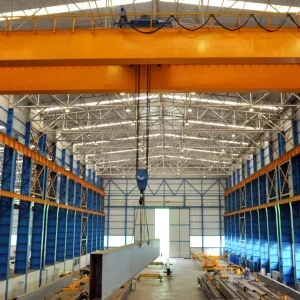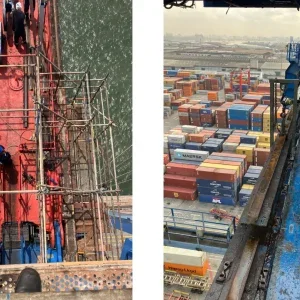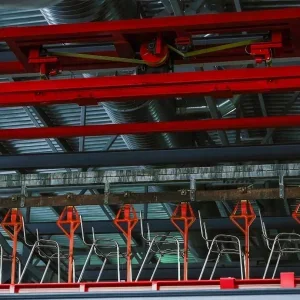Among the key projects the company has been integral to over the last 12 months is in the provision of several overhead cranes that formed part of the reconstruction process of a busy warehouse that was severely damaged by a fire. The site in Fareham, which is owned by heat transfer product manufacturer Kelvion, became engulfed in a huge blaze overnight during March 2014. The incident that resulted in the loss of a fifth of its facility.
Nearly two years later however, the site is back up and running. To aid this process, Pelloby provided a number of single girder travelling cranes that span across adjacent gantry supports, which run the length of the building.
This means that cranage access is provided to nearly every inch of the warehouse. The cranes, which vary in capacity, are used to transport the bulky heat transfer products between stations in the building to aid further engineering work to be carried out.
Kelvion production manager, Ryan Davis, said that Pelloby were the "natural choice" of supplier to replace the beam cranes in the warehouse.
"Kelvion have worked with Pelloby for many years, and we were therefore well aware of their product quality. They not only supplied the old beam cranes that were damaged in the fire, but have also produced various monorail and jib cranes for other buildings at our Fareham site," he concluded.
BESPOKE PROJECT
On another project, the crane manufacturer has recently installed a bespoke inverted travelling jib crane at the Science and Technology Facilities Council (STFC) ISIS complex, which is located at the Rutherford Appleton Laboratory near Oxford UK.
The world-leading materials research centre, ISIS produces beams of neutrons and muons that delve into the complexity of matter using a suite of beamline instruments.
This gives unique insights into the properties of materials on the atomic scale.
Pelloby was involved in providing a series of three adjacent overhead cranes that span the width of one of the two large experimental halls onsite. This allows for access to the various beam defining equipment areas.
However, with the building’s capabilities expanded to accommodate additional instruments, some of the new beam defining equipment areas were located in a ‘crane dead zone,’ which the company’s existing overhead cranes were unable to reach.
Pelloby was tasked with developing a lifting solution to give ISIS suitable crane access to these dead zone areas in order to lift beamline instrument components. Working in conjunction with STFC engineers, Pelloby designers developed an inverted travelling jib crane that can traverse the length of the building along a 53m gantry support rail system.
It does this while also providing continuous 360deg access in a 5m radius owing to a powered rotating jib arm. The company explained: "As the crane needed to access awkward spaces, operators had to be able to navigate it around obstacles such as building stanchions and existing machinery. "It is, therefore, operated via an easy-touse handheld radio control system which governs the longitudinal travelling motion, the jib arm rotation and the movement of the electrically powered short headroom wire rope hoist.
"Anti-clash sensors were fitted to the jib arm, which means the system automatically stops moving when it detects it is approaching another object."
SLEWING JIB
Another successful project undertaken by Pelloby was to design, manufacture and install a 360 degree power slewing jib crane complete with a five tonne safe working load at Yarmouth Harbour on the Isle of Wight.
The crane provides dockside access for a number of boats using the harbour on a daily basis.
Owing to its 360 degree rotation and seven metre height, the crane is capable of loading and unloading goods, and equipment, or for lifting vessels out of the water for a range of maintenance purposes. The manufacturer said that, to ensure its longevity when operating in the strenuous environmental conditions of a marine application, it employed a galvanised and epoxy paint finish.
This would ensure the system was protected against the effects of rust and wear caused by seawater, wind and rain.






